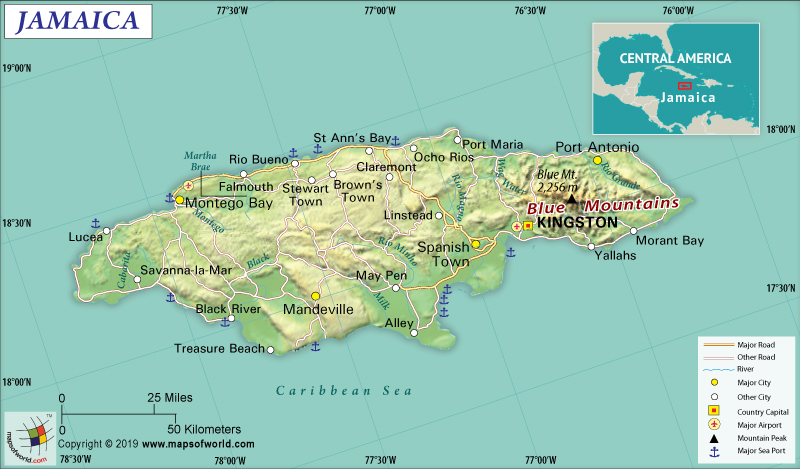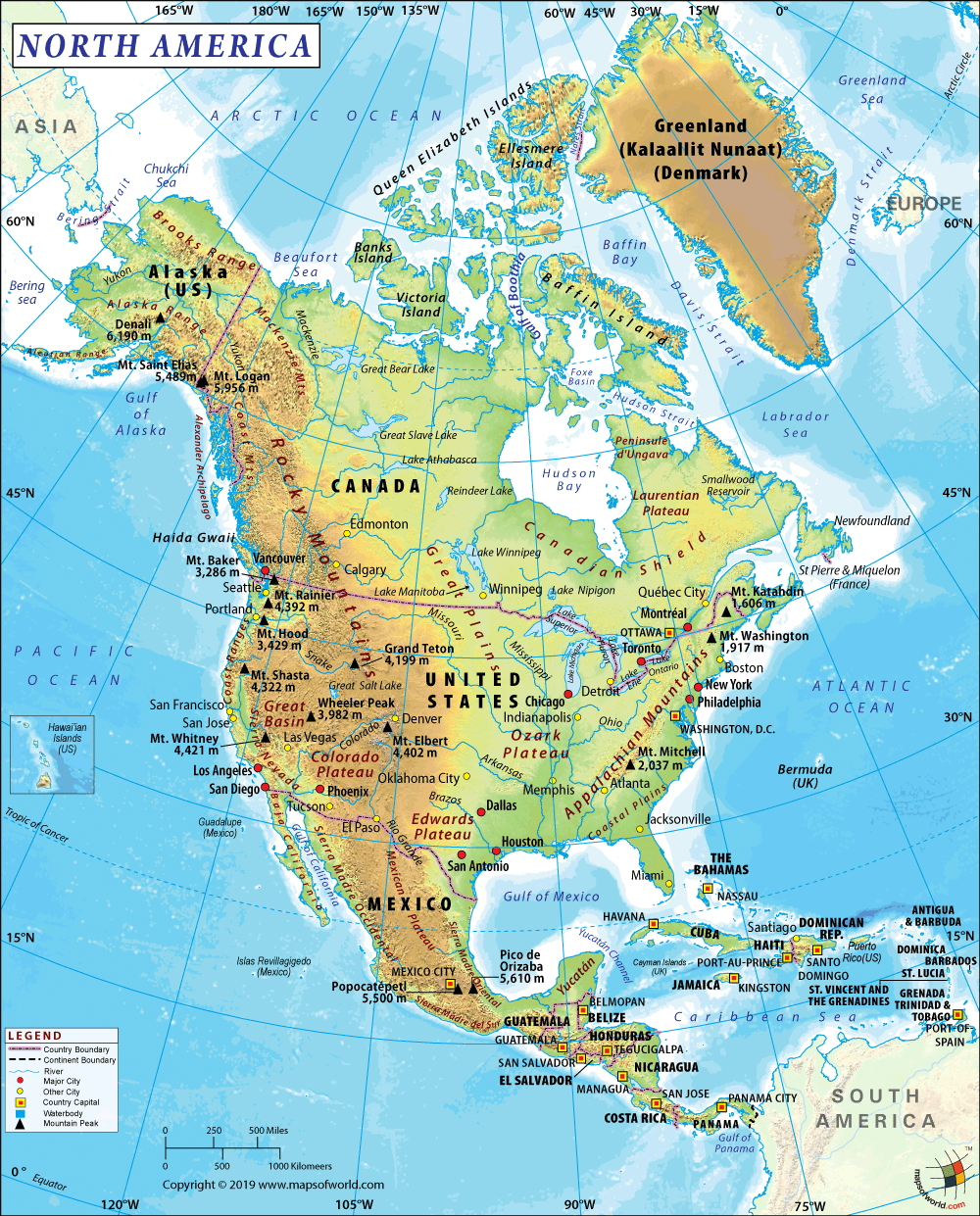What are the Key Facts of Jamaica?

|
Official Name |
Jamaica |
|
Continent |
North America |
|
Capital |
Kingston |
|
Largest City |
Kingston |
|
Coordinates |
18.250000, -77.500000 |
|
Area |
4,244 sq. mi ( 10,991 sq. km) |
|
Land Boundaries |
0 mi ( 0 km) |
|
Coastline |
635 mi ( 1,022 km) |
|
Currency |
Jamaican dollar (JMD) |
|
Neighboring Countries |
Maritime neighbors: Cuba, Haiti |
|
Population |
2,890,299 (2017 est. ) |
|
Official Languages |
English |
|
Major Religion |
Christianity |
|
National Day |
6 August (Independence Day) |
|
National Anthem |
“Jamaica, Land We Love” |
|
Form of Government |
Unitary parliamentary constitutional monarchy |
|
Monarch |
Elizabeth II |
|
Prime Minister |
Andrew Holness |
|
GDP per capita (PPP) |
$ 9,298.8 (World Bank, 2018) |
|
GDP per capita (nominal) |
$ 5,355.6 (World Bank, 2018) |
|
HDI |
0.732 (2017), Rank: 97 |
|
Literacy Rate (%) |
NA |
|
Space Agency |
NA |
|
Military Expenditure Ranking |
113 (SIPRI, 2017) |
|
No. of Olympic Medals |
78 (as of 2018) |
|
Driving Side |
left |
|
Calling Code |
+1-876 |
|
Time Zone |
UTC-5 |
|
Internet TLD |
.jm |
Where is Jamaica?
Jamaica is a Caribbean island country that is also a part of the Greater Antilles. It is located to the south of Cuba (145 km or 90 mi away) and the west of Hispaniola (191 km or 119 mi away).
What is the Geography of Jamaica?
Jamaica is spread over a total area of 10,991 sq. km (4,244 sq. mi), out of which 10,831 sq. km (6,730 sq. mi) is land area and 160 sq. km (99 sq. mi) is water area. It has no land boundary and the coastline is 1,022 km (635 mi) long. Major rivers of Jamaica are South Negril River, Middle River, North Negril River, Green Island River, Orange River, and many more.
The Jamaican island nation along with the other Antilles countries evolved from an arc of ancient volcanoes millions of years back. Thick layers of limestone (thousands of feet thick in many places) were formed on these islands (made up of old igneous and metamorphic rocks) when they were still submerged.
The landforms of Jamaica can be divided into three parts: the mountain chain in the central region, the Cockpit area having karst limestone hills, and the coastal plains along with the interior valleys.
Blue Mountains range is the highest area in the country. Blue Mountain Peak is the highest elevation point (2,256 m or 7,402 ft) of Jamaica. Other major mountains are the John Crow Mountains, Mocho Mountains, and Juan de Bolas Mountain. Caribbean Sea level is the lowest elevation point of this island nation. Jamaica’s mean elevation is 18 m (59 ft).
Two-thirds of Jamaica is covered by the limestone plateau. Therefore, the most prevalent land formation on the island is the karst topography. Some of the characteristic features of karst landscape are residual red or terra rosa soils, hummocky hills, disappearing streams, sinkholes, caves, caverns, and rugged terrain.
The Cockpit Country has characteristic steep-sided hollows that are sometimes as deep as 120 m (390 ft), separated by conical hills/ridges. A long ridge called “Escarpment” is spread from Flagstaff in the western part of Jamaica to the beginning of Barbecue Bottom Road (B10).
Jamaica has two types of climates: an upland tropical climate and a semiarid climate. While the former climate is found on the windward side of the mountains, the latter climatic condition is prevalent on the leeward side.
Rainfall continues throughout the year, thanks to the warm trade winds that blow from the eastern and northeastern parts of the country. Heaviest rainfall takes place during May-to-October. Around 1,960 mm (77.2 in) of average rainfall takes place every year. The mountain areas that face the east and northern parts get a greater amount of rainfall.
The temperature remains fairly constant across the year. While the lowlands have an average temperature ranging from 23.5 to 30 °C (74.3-to-86.0 °F), the higher elevations have an average temperature within 15 to 22 °C (59.0-to-71.6 °F). At Blue Mountain peak, the average temperature can be below 10 °C (50 °F).
What is the Economy of Jamaica?
Jamaica is an upper-middle-income country. It has a mixed economy that is mainly based on agriculture, tourism, manufacturing, mining, petroleum refining, and finance/insurance services. Over 70% of the GDP contribution comes from the services sector, followed by over 20% from the industrial sector.
In fact, both the mining and tourism sectors earn most of the foreign exchanges. On average, 4.3 million foreign tourists visit Jamaica per year. The nominal GDP of Jamaica in 2018 was US$15.718 billion and its economic growth was 1.9% (World Bank). Despite the low level of inequality in the country, the percentage of the population living under the poverty line is around 20%.
The Jamaican economy is currently suffering from high public debt, low rate of economic growth, and high exposure to external shocks. In 2013, the country launched an ambitious reform program for reducing debt, increasing economic growth, and stabilizing the economy. The economy has started improving and in 2018-19 the public debt has fallen below 100% of the GDP. It is expected to further come down to below 60% by 2025-26.
What is the Transportation System of Jamaica?
Roadway network is the backbone of the Jamaican transport system. 22,121 km (13,745 mi) of roadways are present in Jamaica, out of which 16,148 km (10,034 mi) are paved and 5,973 km (3,711 mi) unpaved.
There are 28 airports in Jamaica, out of which 11 have paved runways and 17 have unpaved runways. The international airports are Norman Manley International Airport, Ian Fleming International Airport, and Sir Donald Sangster International Airport.
Only 272 km (169 mi) of railways are present in the country, out of which just 57 km (35 mi) are operational. Most of them transport bauxite. The major seaports are Discovery Bay, Rocky Point, Port Kaiser, Port Esquivel, Port Antonio, Montego Bay, and Kingston. 43 merchant marine ships are also there in the country.
What International Organizations is Jamaica part of?
WTO, IMF, ACP, Petrocaribe, AOSIS, C, UN, Interpol, UNIDO, Caricom, NAM, CDB, UNWTO, CELAC, WMO, FAO, G-15, UNESCO, G-77, IADB, IAEA, ILO, IBRD, ICAO, ICRM, IDA, IFAD, IFC, IFRCS, IHO, IMO, IOC, IOM, ISO, ITSO, ITU, LAES, MIGA, OAS, OPANAL, OPCW, UNCTAD, UNITAR, UPU, WCO, WHO, WIPO, ICC (NGOs), WFTU (NGOs)


